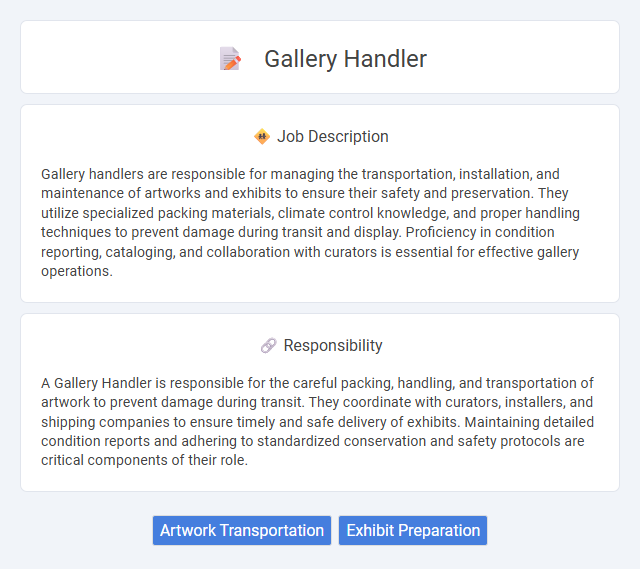
Gallery handlers are responsible for managing the transportation, installation, and maintenance of artworks and exhibits to ensure their safety and preservation. They utilize specialized packing materials, climate control knowledge, and proper handling techniques to prevent damage during transit and display. Proficiency in condition reporting, cataloging, and collaboration with curators is essential for effective gallery operations.
Gallery handlers probably need to possess strong attention to detail and physical stamina due to the careful handling and setup of artwork. Individuals who are patient, organized, and comfortable with manual tasks might be well-suited for this role, while those who struggle with repetitive motions or high responsibility for valuable items may find it challenging. The suitability for the job likely depends on a person's ability to maintain concentration and handle delicate materials safely under pressure.
Qualification
A Gallery Handler requires expertise in art handling, including the careful packing, transportation, and installation of artworks to prevent damage. Proficiency in condition reporting, inventory management, and knowledge of material sensitivities is essential. Experience with specialized equipment and a strong understanding of gallery safety and preservation protocols are critical qualifications for this role.
Responsibility
A Gallery Handler is responsible for the careful packing, handling, and transportation of artwork to prevent damage during transit. They coordinate with curators, installers, and shipping companies to ensure timely and safe delivery of exhibits. Maintaining detailed condition reports and adhering to standardized conservation and safety protocols are critical components of their role.
Benefit
Gallery handler jobs likely offer the benefit of working closely with valuable and rare artworks, providing a unique opportunity to develop expertise in art handling and preservation. This role probably enhances skills in logistics and careful material management, which are highly transferable within the art and museum sectors. The position may also provide a collaborative work environment, fostering connections with artists, curators, and other cultural professionals.
Challenge
Handling a gallery likely presents challenges related to managing diverse artworks and coordinating exhibitions under tight deadlines. The job may require problem-solving skills to address unexpected issues such as artwork damage or logistical delays. Navigating customer expectations and maintaining the gallery's reputation probably demands constant vigilance and adaptability.
Career Advancement
A Gallery Handler plays a crucial role in the art industry by managing, transporting, and installing artworks with precision and care, ensuring their safety and presentation. Career advancement opportunities include progressing to roles such as Collections Manager, Exhibition Coordinator, or Art Logistics Specialist, which involve greater responsibility in curatorial decisions, project management, and client relations. Developing expertise in art handling techniques and industry-standard preservation methods can significantly enhance prospects for leadership positions within galleries and museums.
Key Terms
Artwork Transportation
Gallery handlers specializing in artwork transportation ensure the safe and secure movement of valuable pieces between locations, using custom crates and climate-controlled vehicles to prevent damage. Their expertise includes careful packing, handling, and installation, adhering to strict conservation standards and coordinating logistics with curators and transport companies. Efficient artwork transportation by gallery handlers minimizes risk and preserves the integrity of art collections during transit.
Exhibit Preparation
Exhibit preparation in a gallery handler job involves meticulously managing the handling, packing, and installation of artworks to ensure their safety and integrity. This role requires expertise in proper material use, climate control awareness, and adherence to conservation standards to preserve the condition of each piece. Precise coordination with curators and conservators guarantees that exhibits are assembled accurately and ready for public display.
 kuljobs.com
kuljobs.com